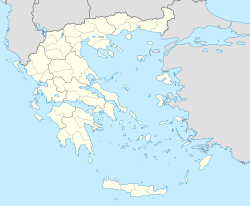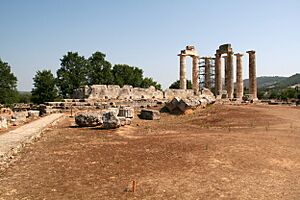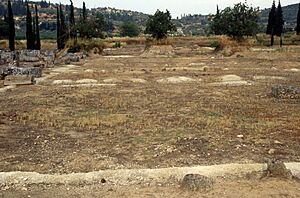Nemea facts for kids
|
Νεμέα
|
|

The stadion of Nemea
|
|
| Location | Archaia Nemea, Corinthia, Greece |
|---|---|
| Region | Argolis (ancient Greece) |
| Coordinates | 37°48′32″N 22°42′37″E / 37.80889°N 22.71028°E |
| Type | Settlement |
| History | |
| Events | Battle of Nemea |
Nemea (/ˈniːmiə/; Ancient Greek: Νεμέα) is an ancient place in the northeastern part of Greece. It is in the Corinthia area today. The small village of Archaia Nemea is right next to the old site. A newer town called Nemea is also nearby.
In Greek mythology, Nemea is famous. This is where the hero Heracles fought and defeated the mighty Nemean Lion. It was also a very important place in ancient times. The Nemean Games were held here. These games were a bit like the ancient Olympics.
Contents
Myths and History of Nemea
Nemea is well-known in Greek myths. It was home to the fierce Nemean Lion. This lion was a huge monster that could not be harmed by weapons. The hero Heracles had to kill it as one of his twelve difficult tasks. He finally defeated the lion using his bare hands.
Another sad story from Nemea is about a baby named Opheltes. He was killed by a snake. In his memory, the Nemean Games were started. The winners of these games received a crown made of parsley or wild celery. The judges wore black robes as a sign of mourning for Opheltes. The Nemean Games began around 573 BC or even earlier. They took place at the special area for Zeus.
The Temple of Zeus is a very important building at Nemea. It was built around 330 BC. Only three of its original stone columns have stood since then. Two more columns were put back up in 2002. As of 2007, four more were being rebuilt. This temple shows how ancient Greek buildings changed over time.
Archaeologists have been digging at Nemea since 1973. They have found a large outdoor altar, baths, and places where visitors stayed. The temple was built on top of an even older temple from an earlier time. The ancient stadium has also been found. It has a well-preserved tunnel that athletes used to enter the track. This tunnel was built around 320 BC. You can still see old drawings and writings on its walls.
All the amazing things found during the digs are shown in a museum at the site. This museum was built by the University of California. In 2018, archaeologists found a large, untouched tomb. It dates back to the early Mycenaean era (1650–1400 BC).
The Battle of the Nemea River
In 394 BC, a big battle happened near Nemea. It was called the Battle of the Nemea River. The city of Sparta and its friends fought against a group of other Greek cities. These included Athens and Corinth.
Sparta won this battle. It was one of their last big victories. The fighting was like other Greek battles of the time. Soldiers called hoplites fought in tight groups. The Spartans were very good at working together. They used their skills to defeat the Athenians. Even though some of Sparta's allies lost many soldiers, Sparta still won the battle.
Cool Features of the Nemea Site
Temple of Zeus
The Temple of Zeus is the most famous part of ancient Nemea. It is in a large sacred area with many other buildings. The temple you see today was built around 330 BC. But it stands on the spot of an even older temple. That first temple was destroyed by fire. So, the people of Nemea built the new one on top of its ruins.
The current temple was very large. It was mostly made of limestone. It used to have 32 columns around its outside. Only three of these columns are still standing today. Six more columns have been rebuilt so visitors can imagine how grand it looked. The temple was partly put back together to help people see its huge size.
The Temple of Zeus used three different styles of ancient Greek architecture. These are the Doric, Corinthian, and Ionic styles. The Doric columns were on the outside. The Corinthian style was used for columns inside. The Ionic style was used for the second floor. The finished temple did not have any carved decorations. Its design was simple but very precise and carefully made.
The Hellenistic Stadium
The Nemean Stadium was dug up by archaeologists from 1974 to 1981. The natural shape of the land was perfect for building it. Two hills created a natural bowl for the stadium. The running track was originally about 600 feet long. There was a water channel on both sides of the track. This channel also had a water basin and a 300-foot marker.
The stadium also had special "front row seats." These were limestone blocks placed along the water channel. They were probably for important people watching the games.
A cool part of the stadium is its 36-meter-long tunnel. This tunnel shows that ancient Greek builders knew how to create complex structures. You can still see old graffiti on the tunnel walls. One name carved there is "Telestas." He was a known winner of ancient Olympic games.
There was also a room called the apodyterion, or locker room. Athletes used this space to get ready for their competitions. They would take off their clothes and rub olive oil on their bodies. Roof tiles in the apodyterion have stamps with the architect's name, Sosikles.
The Nemean Games were held at this stadium every two years. Nemea was one of four main places for these big competitions. The others were Delphi, Isthmia, and Olympia. All Greeks came together for these events. A special truce was called to stop all wars. This way, everyone could travel safely to watch the games. The stadium track had to be dug up and leveled every two years. This kept it flat and ready for the races.
The Oikoi
South of the Temple of Zeus, there are nine old buildings. They are called oikoi (pronounced "OY-koy"). This Greek word usually means "house." But the exact purpose of these buildings is not fully clear. They are lined up facing north, similar to buildings found at Olympia. They might have been used as treasuries or meeting halls.
The first oikoi were found in the 1920s. But they were not fully dug up until the 1970s. Over time, farming and people taking building materials damaged the site. So, only the stone foundations of the oikoi remain today.
The first oikos is the biggest. It measures about 22.40 by 13.15 meters. The eighth oikos had a well in its back room. This well might have been used for preparing meals. Later, this oikos became a workshop for bronze sculpting. The ninth oikos was a cooking area for a dining place next door. This dining place was connected to the eighth and ninth oikoi. It could hold up to eleven dining couches. Ash and pig bones found there suggest that people had special meals and sacrifices.
See also





